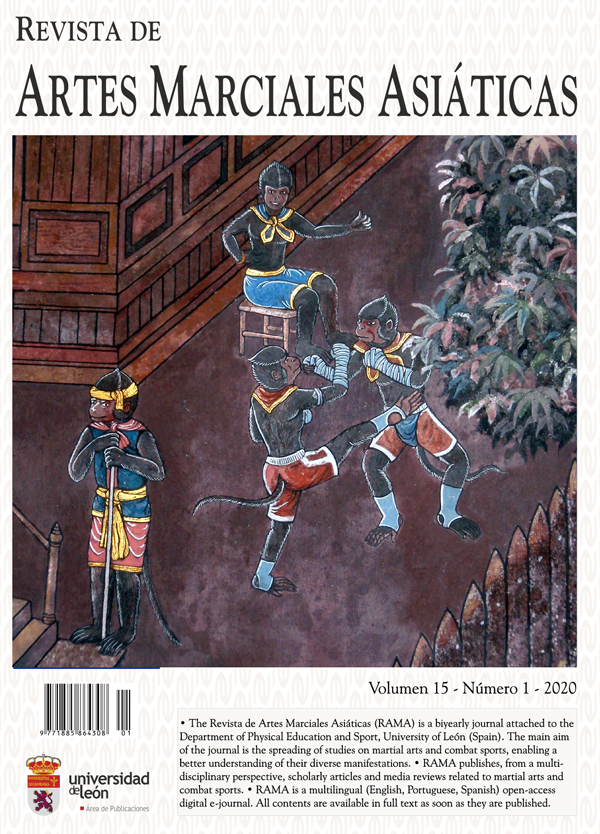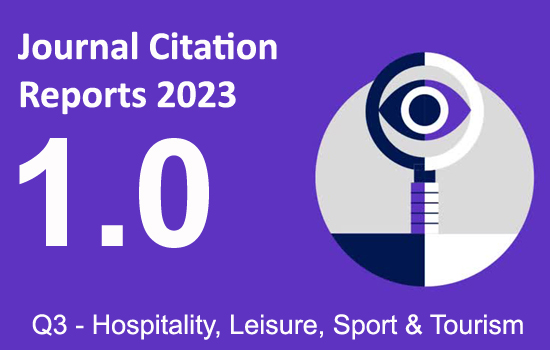El entrenamiento intervalado de alta intensidad mejora el rendimiento específico en los atletas de taekwondo
DOI:
https://doi.org/10.18002/rama.v15i1.6041Palabras clave:
Deportes de combate, artes marciales, taekwondo, EIAI, fatiga, rendimiento atlético, HIITAgencias Financiadoras:
POSTDOC_DICYT, Code, 02164OD, Vicerrectoría de Investigación y Desarrollo, Universidad de Santiago de Chile, USACH, Chile.Resumen
Los métodos de entrenamiento específicos son un aspecto importante en la preparación de los atletas de taekwondo. El propósito de este estudio fue investigar el efecto de un programa de entrenamiento intervalado de alta intensidad (EIAI) de corta duración con técnicas específicas de taekwondo sobre el rendimiento anaeróbico. Doce atletas de taekwondo fueron asignados al azar a un grupo control (n=6) o grupo experimental (n=6). El protocolo experimental consistió en 3 bloques de 6 series de esfuerzo total de 10 segundos, con recuperación pasiva de 10 segundos entre series e intervalos de descanso de 1 minuto entre bloques, realizado 3 días por semana durante 4 semanas. Se realizó un análisis de varianza de tres vías (ANOVA) (grupo, serie y tiempo) con mediciones repetidas en los dos últimos factores para comparar el rendimiento durante cada serie de la prueba Frequency Speed Kick Test (FSKT) y un ANOVA de dos vías (grupo y tiempo) con mediciones repetidas se utilizó para comparar el número total de patadas y el índice de fatiga de patadas (IFP). Ambos grupos mantuvieron su entrenamiento regular de taekwondo, que era exactamente el mismo. Antes y después del programa de entrenamiento, los atletas realizaron el FSKT. El grupo experimental aumentó el rendimiento (p <0,01) en cada una de las cinco series de FSKT y en el número total de patadas (p <0,001). No se observó diferencia estadística en el grupo control después de 4 semanas o entre el grupo control y el grupo experimental en ningún momento. Un programa de EIAI de corta duración con técnicas específicas de taekwondo mejoró el rendimiento anaeróbico medido a través del FSKT. Sin embargo, el índice de fatiga no cambió
Descargas
Métricas alternativas
Citas
Bridge, C.A., Jones, M.A., & Drust, B. (2011). The activity profile in international Taekwondo competition is modulated by weight category. International Journal of Sports Physiology and Performance, 6(3), 344-357. doi: https://doi.org/10.1123/ijspp.6.3.344
Bridge, C.A., McNaughton, L.R., Close, G.L., & Drust, B. (2013). Taekwondo exercise protocols do not recreate the physiological responses of championship combat. International Journal of Sports Medicine, 34(7), 573-581. doi: https://doi.org/10.1055/s-0032-1327578
Buchheit, M., & Laursen, P. (2013). High-intensity Interval Training, Solutions to the Programming Puzzle: Part I: Cardiopulmonary Emphasis. Sports Medicina, 43(10), 927-54. doi: https://doi.org/10.1007/s40279-013-0066-5
Farzad, B., Gharakhanlou, R., Agha-Alinejad, H., Curby, D.G., Bayati, M., Bahraminejad, M., et al. (2011). Physiological and performance changes from the addition of a sprint interval program to wrestling training. Journal of Strength and Conditioning Research, 25(9), 2392-2399. doi: https://doi.org/10.1519/JSC.0b013e3181fb4a33
Franchini, E., Julio, U.F., Panissa, V.L.G., Lira, F.S., Agostinho, M.F., & Branco, B.H.M. (2016a). Short-term low-volume high-intensity intermittent training improves judo-specific performance. Archives of Budo, 12, 219-229. doi: https://doi.org/10.1016/j.jsams.2017.01.199
Franchini, E., Julio, U.F., Panissa, V.L., Lira, F.S., Gerosa-Neto, J., & Branco, B.H. (2016b). High-intensity intermittent training positively affects aerobic and anaerobic performance in judo athletes independently of exercise mode. Frontiers in Physiology, 28(7), 268. doi: https://doi.org/10.3389/fphys.2016.00268
Franchini, E., Cormack, S., & Takito, M. Y. (2019). Effects of High-Intensity Interval Training on Olympic Combat Sports Athletes' Performance and Physiological Adaptation: A Systematic Review. Journal of Strength and Conditioning Research, 33(1), 242–252. doi: https://doi.org/10.1519/JSC.0000000000002957
Girard, O., Mendez-Villanueva, A., & Bishop, D. (2011). Repeated-sprint ability - part I: Factors contributing to fatigue. Sports Medicine, 41(8), 673-694. doi: https://doi.org/10.2165/11590550-000000000-00000
Hopkins, W.G. (2016). A new view of statistics: A scale of magnitude for effect statistics. Retrieved July 5, 2017 from http://www.sportsci.org/resource/stats
Kamandulis, S., Bruzas, V., Mockus, P., Snieckus, A., & Venckunas, T. (2018). Sport-specific repeated sprint training improves punching ability and upper-body aerobic power in experienced amateur boxers. Journal of Strength and Conditioning Research, 32(5), 1214–1221. doi: https://doi.org/10.1519/JSC.0000000000002056
Kim, J., Lee, N., Trilk, J., Kim, E.J., Kim, S.Y., Lee, M., et al. (2011). Effects of sprint interval training on elite judoists. International Journal of Sports Medicine, 32(12), 929-934. doi: https://doi.org/10.1055/s-0031-1283183
Lopes-Silva, J.P., Ferreira da Silva Santos, J., Abbiss, C., Franchini, E. (2019). Measurement Properties and Feasibility of Repeated Sprint Ability Test: A Systematic Review. Strength & Conditioning Journal, 41(6), 41-61. doi: https://doi.org/10.1519/SSC.0000000000000495
Monks, L., Seo, M.W., Kim, H.B., Jung, H.C., & Song, J.K. (2017). High-intensity interval training and athletic performance in taekwondo athletes. The Journal of Sports Medicine and Physical Fitness, 57(10), 1252-1260. doi: https://doi.org/10.23736/S0022-4707.17.06853-0
Ravier, G., Dugué, B., Grappe, F., & Rouillon, J.D. (2009). Impressive anaerobic adaptations in elite karate athletes due to few intensive intermittent sessions added to regular karate training. Scandinavian Journal of Medicine & Science in Sports, 19(5), 687-694. doi: https://doi.org/10.1111/j.1600-0838.2008.00807.x
Reilly, T., Morris, T., & Whyte, G. (2009). The specificity of training prescription and physiological assessment: a review. Journal of sports sciences, 27(6), 575–589. doi: https://doi.org/10.1080/02640410902729741
Sadowski, J., Gierczuk, D., Miller, J., & Cieśliński, I. (2012). Success factors in elite WTF taekwondo competitors. Archives of Budo, 8(3), 141-146.
Santos, J.F.S., & Franchini, E. (2018). Frequency speed of kick test performance comparison between female taekwondo athletes. Journal of Strength and Conditioning Research, 32(10), 2934-2938. doi: https://doi.org/10.1519/JSC.0000000000002552
Santos, J.F.S., & Franchini, E. (2016). Is frequency speed of kick test responsive to training? A study with taekwondo athletes. Sport Sciences for Health, 12(3), 377-382. doi: https://doi.org/10.1007/s11332-016-0300-2
Santos, J.F.S., Herrera-Valenzuela, T.H., & Franchini, E. (2015). Can different conditioning activities and rest intervals affect the acute performance of taekwondo turning kick? Journal of Strength and Conditioning Research, 29(6), 1640-1647. doi: https://doi.org/10.1519/JSC.0000000000000808
Santos, J.F.S., Herrera-Valenzuela, T., Mota, G.R., & Franchini, E. (2016). Influence of half-squat intensity and volume on the subsequent countermovement jump and frequency speed of kick test performance taekwondo athletes. Kinesiology, 48(1), 95-102. doi: https://doi.org/10.26582/k.48.1.6
Santos, J.F.S., Loturco, I., & Franchini, E. (2018). Relationship between frequency speed of kick test performance, optimal load, and anthropometric variables in black-belt taekwondo athletes. Ido Movement for Culture. Journal of Martial Arts Anthropology, 18(1), 39-44. doi: https://doi.org/10.14589/ido.18.1.6
Zagatto, A. M., Beck, W. R., & Gobatto, C. A. (2009). Validity of the running anaerobic sprint test for assessing anaerobic power and predicting short-distance performances. Journal of Strength and Conditioning Research, 23(6), 1820–1827. doi: https://doi.org/10.1519/JSC.0b013e3181b3df32
Descargas
Publicado
Cómo citar
Número
Sección
Licencia
Derechos de autor 2020 Diego Enrique Aravena Tapia, Valeria Román Barrera, Jonatas Ferreira Da Silva Santos, Emerson Franchini, Pablo Valdés-Badilla, Pedro Orihuela, Tomás Herrera-Valenzuela

Esta obra está bajo una licencia internacional Creative Commons Atribución-NoComercial-CompartirIgual 4.0.
Los autores que publican en esta revista están de acuerdo con los siguientes términos:
- Los autores ceden de forma no exclusiva los derechos de explotación (reproducción, distribución, comunicación pública, transformación) a la Universidad de León, por lo que pueden establecer, por separado, acuerdos adicionales para la distribución no exclusiva de la versión de la obra publicada en la revista (por ejemplo, alojarlo en un repositorio institucional o publicarlo en un libro), con un reconocimiento de su publicación inicial en esta revista.
- Este trabajo se encuentra bajo la Creative Commons Attribution-NonCommercial-ShareAlike 4.0 International License. Puede consultarse desde aquí la versión informativa y el texto legal de la licencia.
- Se permite y se anima a los autores a difundir electrónicamente las versiones pre-print (versión antes de ser evaluada) y/o post-print (versión evaluada y aceptada para su publicación) de sus obras antes de su publicación, ya que favorece su circulación y difusión más temprana y con ello un posible aumento en su citación y alcance entre la comunidad académica.











